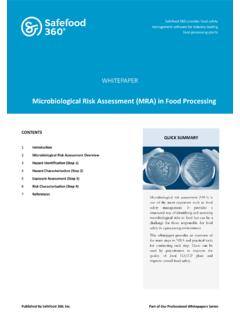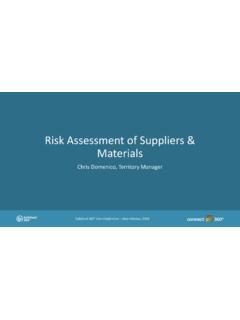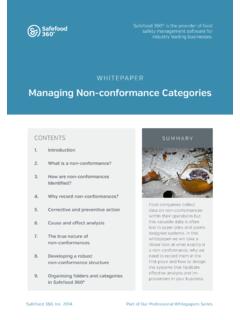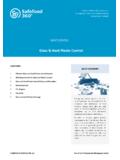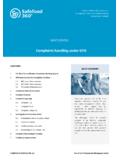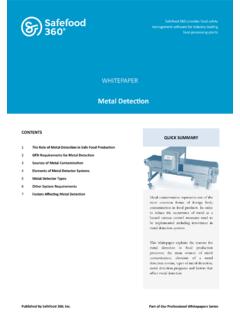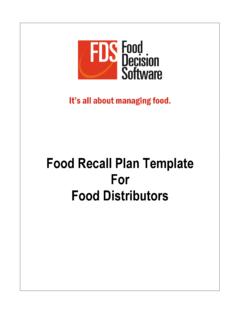Transcription of No Observable Effect Level - Food safety, quality …
1 Chemical hazards are associated with a significant number of high profile food safety alerts, recalls and withdrawals. The principles of HACCP require chemical hazards to be considered during the hazard identification and risk assessment stage and appropriate controls put in place to reduce their potential to occur and create an impact. This whitepaper explores basics of chemical hazards and explains how toxins work in the human body. Control measures and risk assessment are also covered as well as some of the most common sources of chemical hazard data. Chemical hazards are associated with a significant number of high profile food safety alerts, recalls and withdrawals. The principles of HACCP require chemical hazards to be considered during the hazard identification and risk assessment stage, and appropriate controls put in place to reduce their potential to occur and their impact. Chemical hazards can come from a variety of sources. These can be internal from within the food processing business and external associated with environmental and naturally occurring sources.
2 On occasion they can be intrinsic to the food itself and intentionally added as part of the product formulation. While many of these hazards and sources can be relatively easy to identify, it is common for many HACCP teams to overlook and incorrectly risk assess chemical hazards. This is often due to a poor understanding of chemical hazards, the science of toxicology and the mechanisms behind the ef- fects of chemicals on the human body. This whitepaper provides important information on chemical hazards and supports the develop- ment and understanding of HACCP based food safety controls. It addresses the main categories of chemical hazards associated with food and the toxicology of these hazards. This information can be used to assist in the development of more robust and informed HACCP plans. The first section will cover toxicology. Following this we will cover the main chemical hazards and finally we will provide some good reference sources to help you drill down into more detailed data required for hazard analysis and risk assessment.
3 Toxicology is the science of poisons. When it comes to chemical hazards in food safety, an under- standing of toxicology is helpful in conducting risk assessments and developing your food safety controls. In general, it is the study of harmful interactions between chemicals and biological sys- tems. The origin of these toxic substances can be drugs, food additives, pesticides, industrial chem- icals, environmental pollutants and natural toxins. The following are some useful terms used in the area of toxicology: The fundamental principles of chemical toxicology are the dose and response. It is the relationship between the Level of toxin and the adverse response arising from the dose. For many individuals there is a dose Level at which there is no Observable response. This is known as NOEL, which stands for No Observable Effect Level . Above this Level the effects will be Observable and the relation- ship can be shown on a Dose Response Curve as is shown below. Figure 1: LD50 Dose Response Curve Sample In this curve we can see the impacts of a specific dose on the population including the Lethal Dose (LD).
4 A common measure used is the LD50. This is the lethal dose that produces death in 50% of exposed organisms. It is used to compare toxins. The LD50 is often derived for humans from ani- mal data. It is important to note that for many toxic substances death is not the only consideration for toxicity. Other effects will occur at lower doses and must be assessed as well. From this data it is possible to calculate the Acceptable Daily Intake (ADI) as follows: The following are examples of some LD50 Values Classification of the toxicity of chemicals can be as follows: To cause death a toxin must interfere with some process in the body that is essential for survival. In most cases toxic chemicals exert their toxin effects by bonding to proteins - enzymes or recep- tors - or membrane components. The chemical toxin may affect a particular organ or tissue, brain, liver or kidney. The following table summarises how some common toxins work. Toxins can enter the body through a number of routes of exposure.
5 After entry into the body, toxins must be transported to the tissues. This is usually achieved through the blood system. Once the target tissue has been reached the toxin must have the ability to cross cell membranes in order to damage the cell. Some chemical toxins persist in the body for long periods and are only slowly eliminated. However, in general most toxic chemicals do not re- main in the body but are excreted. Excretion occurs through urine, sweat, bile (fatty materials) and other fluids such as breast milk. Most chemicals entering the body pass through 3 main phases:'. 1. Absorption where the chemical enters the circulation from the point of exposure 2. Distribution where the chemical is translocated within the body 3. Elimination where the chemical is excreted from the body In cases where the chemical does not pass from the body without change, the body chemistry can alter the toxin by a number of reactions called biotransformations. These reactions are most likely to occur in the liver which is the major site of detoxification in the body.
6 The process is carried out by a wide range of broad specificity enzymes which make the toxic chemicals more water soluble so that they will more easily pass out in the urine. When it comes to assessing chemical hazard risk for food safety there are a number of specific are- as which require consideration: Exposure assessment, daily intake Dose-response data Toxicity testing data from humans or animal data for extrapolation Data for extrapolation from short term to long term exposure ADI data Data on mechanism of action of toxic effects In practice, obtaining all this data for a specific chemical hazard may be time consuming, not avail- able and require certain knowledge and expertise to interpret. In such cases where either expertise or resources are not available, use of a consultant should be considered when developing and re- viewing HACCP plans. When developing your HACCP plan it is vital that good quality information is used to inform the team regarding specific chemical hazards. This information should include hazard characterisation, dose response, and mode of action.
7 The following are some websites which provide high quality and regularly updated information on chemical hazards. An excellent source of data on chemical hazards associated with ingredients and chemicals used within the food processing plant is the Material Safety Data Sheet (MSDS). Under legislation, sup- pliers of specific materials, chemicals and other substances are required to provide these datasheets to users of their products. While these are intended for occupational health and safety situations they also provide excellent data on the nature and composition of the chemical, toxicity and health effects of various substances. During the development of HACCP plans it is important to clearly identify the specific chemical hazards that may arise regarding your products and processes. The following table provides a com- prehensive list of the most common chemical hazards. The control measures applied for chemical hazard depend on the specific hazard in question. It is important to research fully valid methods of control as part of your HACCP planning process.
8 Some examples of control measures include: Good Agricultural Practice (GAP) measures Transport and storage control including temperature control, moisture control, Aw, separation, etc. Heat treatment Hygiene control Inspection and release programs.
